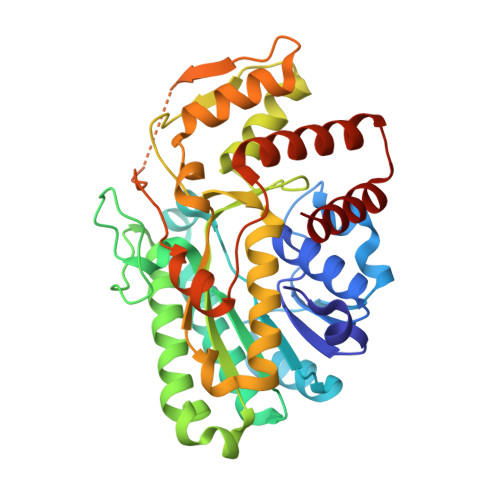Structure of CDP-D-glucose 4,6-dehydratase from Salmonella typhi complexed with CDP-D-xylose.
Koropatkin, N.M., Holden, H.M.(2005) Acta Crystallogr D Biol Crystallogr 61: 365-373
- PubMed: 15805590
- DOI: https://doi.org/10.1107/S0907444904033876
- Primary Citation of Related Structures:
1WVG - PubMed Abstract:
Tyvelose is a unique 3,6-dideoxyhexose found in the O antigens of some pathogenic species of Yersinia and Salmonella. It is produced via a complex biochemical pathway that employs CDP-D-glucose as the starting ligand. CDP-D-glucose 4,6-dehydratase catalyzes the first irreversible step in the synthesis of this 3,6-dideoxysugar by converting CDP-D-glucose to CDP-4-keto-6-deoxyglucose via an NAD+ -dependent intramolecular oxidation-reduction reaction. Here, the cloning, protein purification and X-ray crystallographic analysis of CDP-D-glucose 4,6-dehydratase from Salmonella typhi complexed with the substrate analog CDP-D-xylose are described. Each subunit of the tetrameric enzyme folds into two domains. The N-terminal region contains a Rossmann fold and provides the platform for NAD(H) binding. The C-terminal motif is primarily composed of alpha-helices and houses the binding pocket for the CDP portion of the CDP-D-xylose ligand. The xylose moiety extends into the active-site cleft that is located between the two domains. Key residues involved in anchoring the sugar group to the protein include Ser134, Tyr159, Asn197 and Arg208. Strikingly, Ser134 O gamma and Tyr159 O eta sit within 2.9 A of the 4'-hydroxyl group of xylose. Additionally, the side chains of Asp135 and Lys136 are located at 3.5 and 3.2 A, respectively, from C-5 of xylose. In the structurally related dTDP-D-glucose 4,6-dehydratase, the Asp/Lys pair is replaced with an Asp/Glu couple. On the basis of this investigation, it can be speculated that Tyr159 serves as the catalytic base to abstract the 4'-hydroxyl proton from the sugar and that Asp135 and Lys136 play critical roles in the subsequent dehydration step that leads to the final product.
Organizational Affiliation:
Department of Biochemistry, University of Wisconsin, Madison, Wisconsin 53706-1544, USA.
















